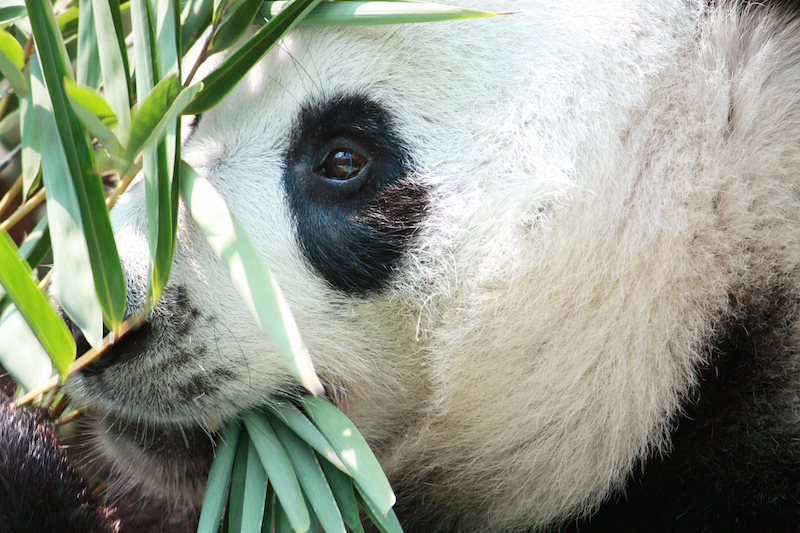Panda Poop Reveals They're Bad at Digesting Bamboo

Even though bamboo is their main food source, giant pandas are horrible at digesting it, a new study of their gut bacteria finds.
A look at the giant-panda gut microbiome (bacteria living in the stomach and intestines) showed that the animals have relatively few bacteria that help digest fibrous plants such as bamboo. Instead, most of the panda's gut is covered with bacteria such as Escherichia/Shigella and Streptococcus, organisms typically found in meat eaters, the researchers said.
These bacteria may be leftovers from an ancestor, the researchers said. The giant panda (Ailuropoda melanoleuca) evolved from bears that ate both plants and meat. Ancient giant pandas likely began eating bamboo about 7 million years ago but became exclusive bamboo eaters about 2 million years ago, the researchers noted. [Baby Panda Pics: See A Cub Growing Up]
Yet modern pandas spend about 14 hours a day eating bamboo, and it isn't an easy food for them to digest. Over time, the giant panda developed a powerful jaw and teeth to help it chew the fibrous plant. It also developed enlarged pseudothumbs (a wrist bone that acts like a thumb) to help it grasp bamboo stems, the researchers wrote in the study. But the animal's gut still looks like that of a carnivore, and it can digest only about 17 percent of the bamboo it eats, the researchers said.
"Unlike other plant-eating animals that have successfully evolved anatomically specialized digestive systems to efficiently deconstruct fibrous plant matter, the giant panda still retains a gastrointestinal tract typical of carnivores," Zhihe Zhang, the study's lead author and director of the Chengdu Research Base of Giant Panda Breeding in China, said in a statement.
"The animals also do not have the genes for plant-digesting enzymes in their own genome," Zhang said. "This combined scenario may have increased their risk for extinction."
In the study, researchers did a genetic analysis of the gut bacteria in the poop of 45 healthy pandas living at the Chengdu Research Base. After about one year, they collected 112 fecal samples from panda cubs, juveniles and adults. Except for the cubs, which drank milk, each panda ate about 22 lbs. (10 kilograms) of bamboo and bamboo shoots, as well as up to 1.7 lbs. (800 grams) of steamed bread every day.
Get the world’s most fascinating discoveries delivered straight to your inbox.
But the feces were full of undigested bamboo fragments, the researchers found.
"This result is unexpected and quite interesting, because it implies the giant panda's gut microbiota may not have well adapted to its unique diet, and places pandas at an evolutionary dilemma," said study co-author Xiaoyan Pang, an associate professor in the School of Life Sciences and Biotechnology at Shanghai Jiao Tong University in China.
All of the giant pandas, including nine captive and seven wild pandas previously studied, had a low diversity of gut microbiota. Moreover, the animal's microbiome didn't contain plant-degrading bacteria, such as Ruminococcaceae and Bacteroides, which are widespread in other herbivorous animals.
However, the microbes in their gut did vary by season. For instance, the bacteria are different in the late autumn, when there are no young bamboo shoots, compared to in the spring and summer, Pang said.
The researchers plan to do follow-up work so they can learn more about the panda's gut bacteria, and how the microbes affect the animals' health and nutrition, the researchers said.
The findings were published online today (May 19) in the journal mBio, a publication from the American Society for Microbiology.
Follow Laura Geggel on Twitter @LauraGeggel. Follow Live Science @livescience, Facebook & Google+. Original article on Live Science.

Laura is the managing editor at Live Science. She also runs the archaeology section and the Life's Little Mysteries series. Her work has appeared in The New York Times, Scholastic, Popular Science and Spectrum, a site on autism research. She has won multiple awards from the Society of Professional Journalists and the Washington Newspaper Publishers Association for her reporting at a weekly newspaper near Seattle. Laura holds a bachelor's degree in English literature and psychology from Washington University in St. Louis and a master's degree in science writing from NYU.


